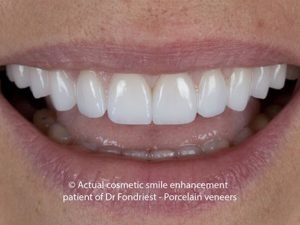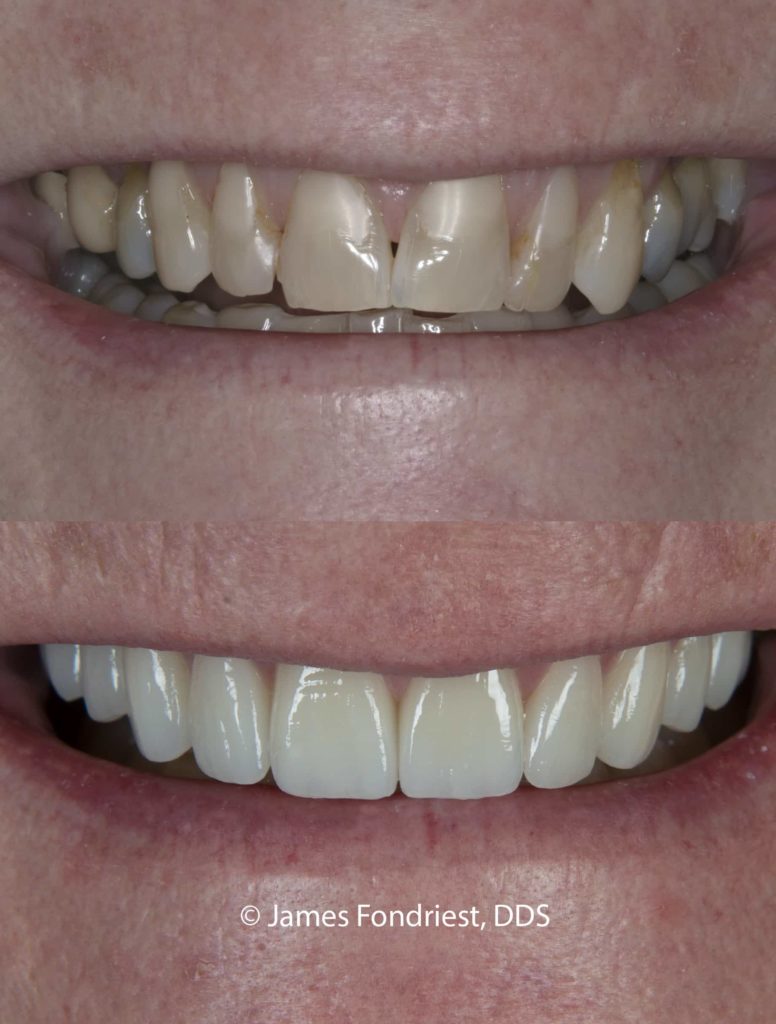
Conservative porcelain veneers are playing a major role in high end cosmetic dentistry. There was a time when only movie stars and politicians could afford this type of cosmetic dentistry. Pictures of their before and after smiles were amazing, and often sent waves of envy through the average Joe. Nowadays, cosmetic dentistry is available and more affordable for a much larger segment of the population.
Porcelain veneers have become a common and popular choice for smile makeovers. As the dental field continues to evolve and advances are made, more and more minimally invasive procedures become available.
Today, besides porcelain veneers there are no preparation or minimum preparation veneers available. The difference is in the material they are fabricated with. If you are interested in learning more about veneers, consult Dr. Fondriest. He will be happy to explain the pros and cons of veneer options available today.

Cover dark, broken or chipped teeth with conservative porcelain veneers without drilling. The final result won’t look like the same mouth.
What Is Minimally Invasive Dentistry?
The goal of minimally invasive dentistry is to keep as much of the original tooth structure and surrounding tissue as possible. There was a time when dentists would reduce teeth down to tiny stubs, especially during elective cosmetic procedures. Some of the materials used required this major tooth reduction.
Dentists know that artificial dentistry is not as long lasting as a natural tooth. The removal of tooth structure limits future restorative options. Therefore the removal of healthy tooth structure should be kept to a minimum. This can accomplished by doing conservative porcelain veneers.
What Is A Veneer?
Porcelain veneers, also called dental laminates, are thin stain resistant jackets of porcelain that cover the original tooth. They can be custom designed to restore function and strength or to improve the aesthetics of a smile. They are considered minimally invasive because they are more conservative than a dental crown. Veneers only need to cover the part of the tooth that needs change. They can correct shape or size, damage or injury, or improve aesthetics.
No-Prep or Low-Prep Veneer
New and improved dental materials are being developed all the time. No-prep or minimum preparation veneers were developed as a minimally invasive restorative option. They require only a small amount of tooth reduction. Dental porcelain used to fabricate porcelain veneers or laminates can be made as thin as 0.2mm. These ultra thin veneers still provide strength, durability, and aesthetics.
Other conservative porcelain veneer materials can be brittle when fabricated thinner than 0.5mm in thickness. The porcelain used for no-prep or low-prep veneers is strong enough to bond without cracking. Because these veneers require minimum preparation, little drilling is required and most of the natural tooth structure is maintained.
When the dentist drills less of the natural tooth, the tooth will be more able to tolerate future dentistry id needed.
Improving aesthetics with conservative porcelain veneers
No-prep or low-prep porcelain materials can be fabricated with varying tinted layers and levels of translucency. The ceramic material is paper thin. Its translucency allows the underlying tooth to show through. The porcelain is blended with the various tints, achieving natural aesthetics while covering imperfections. The esthetic result can be amazing and the life span of veneers is very long.
Regular Veneers vs. Conservative Porcelain Veneers
Porcelain veneers are used to:
- Reshape crooked or misaligned teeth
- Add length and width to anterior teeth
- Cover diastemas, black triangles, and close gaps or spaces
- Repair the cracks, fractures, and chips in natural teeth
- Cover discolored or stained teeth and create a bright, aesthetic smile
- Reestablish an unhealthy tooth due to decay, worn enamel, erosion, or attrition, back to health
Low-prep or no-prep veneers are a good choice for repair:
- Erosion
- Worn enamel
- Attrition
- Decay
- Teeth that appear too small, especially central incisors
- Reverse smile lines
When choosing between the two types of veneers, the amount of tooth reduction is an important consideration. Dr. Fondriest can explain the pros and cons of enamel removal. And how the amount of removal affects the quality of the outcome. For instance, conservative veneers are a good choice when spaces, gingival recession, or loss of gum papillae are not issues.
Creating a uniform morphology, or modest improvements in symmetry and tooth alignment, are often remedied with low-prep veneers. Crowns are recommended if a brighter smile is the goal. Crowns and veneers are the two main cosmetic dental options for transforming your smile.
Conservative porcelain veneers are more difficult to do
Veneer restorations are bonded into place. They are strong and durable, and the margins are less likely to leak or fail. There are many factors the patient, dentist, and ceramist need to consider before choosing veneers with little drilling. Can they change the shapes of teeth enough to accomplish the esthetic and function goals?
Once the technical details are met, how will the teeth look and function? If the patient’s treatment circumstances are not ideal, the use of low prep veneers can prove challenging. It is more difficult to remove excess cement after bonding with this option.
Good oral hygiene is more difficult to maintain due to large changes in root contouring. That’s why it is important to consult with a well trained cosmetic dentist who offers this unique option. Low prep designs are the domain of experienced dentists.These procedures are not taught in dental schools.
Learn more about conservative porcelain veneers
It is in the patient’s best interest for the dentist to do the least amount of drilling. Come learn how treatment planning conservative porcelain veneers can be the best way to enhance your smile.
If you are interested in learning more about smile design and beautifully done artistic smiles, contact Dr. Fondriest. We proudly serve patients from Chicago and all surrounding communities. To schedule a consultation, call our office today at (847) 234-0517.
Dr. Fondriest is a Nationally recognized and highly sought after cosmetic dentist. He serves clients from throughout the United States
